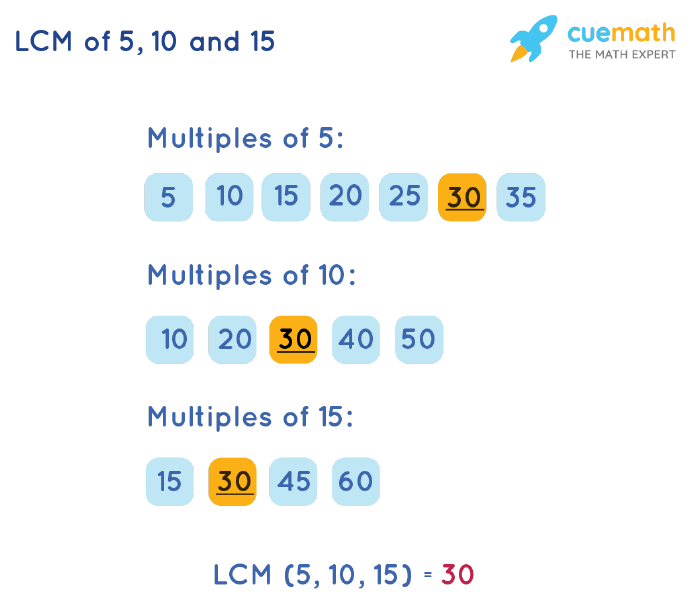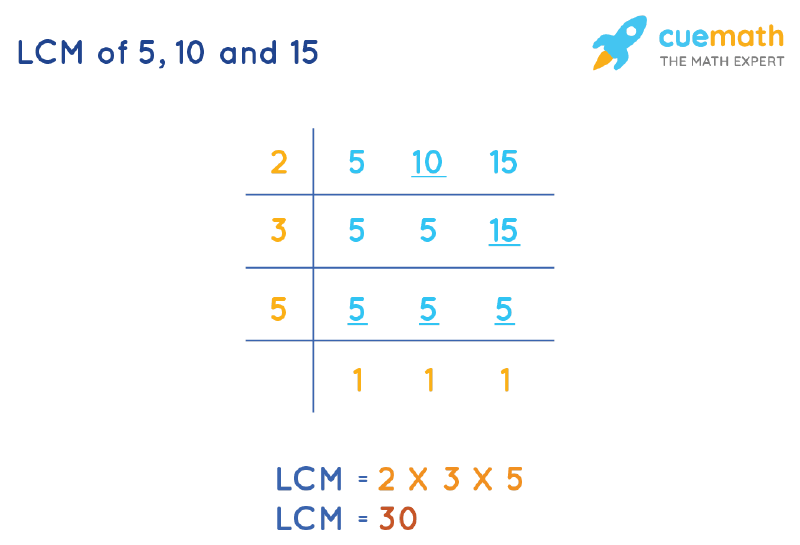LCM of 5, 10, and 15
LCM of 5, 10, and 15 is the smallest number among all common multiples of 5, 10, and 15. The first few multiples of 5, 10, and 15 are (5, 10, 15, 20, 25 . . .), (10, 20, 30, 40, 50 . . .), and (15, 30, 45, 60, 75 . . .) respectively. There are 3 commonly used methods to find LCM of 5, 10, 15 - by listing multiples, by division method, and by prime factorization.
| 1. | LCM of 5, 10, and 15 |
| 2. | List of Methods |
| 3. | Solved Examples |
| 4. | FAQs |
What is the LCM of 5, 10, and 15?
Answer: LCM of 5, 10, and 15 is 30.

Explanation:
The LCM of three non-zero integers, a(5), b(10), and c(15), is the smallest positive integer m(30) that is divisible by a(5), b(10), and c(15) without any remainder.
Methods to Find LCM of 5, 10, and 15
Let's look at the different methods for finding the LCM of 5, 10, and 15.
- By Listing Multiples
- By Division Method
- By Prime Factorization Method
LCM of 5, 10, and 15 by Listing Multiples

To calculate the LCM of 5, 10, 15 by listing out the common multiples, we can follow the given below steps:
- Step 1: List a few multiples of 5 (5, 10, 15, 20, 25 . . .), 10 (10, 20, 30, 40, 50 . . .), and 15 (15, 30, 45, 60, 75 . . .).
- Step 2: The common multiples from the multiples of 5, 10, and 15 are 30, 60, . . .
- Step 3: The smallest common multiple of 5, 10, and 15 is 30.
∴ The least common multiple of 5, 10, and 15 = 30.
LCM of 5, 10, and 15 by Division Method

To calculate the LCM of 5, 10, and 15 by the division method, we will divide the numbers(5, 10, 15) by their prime factors (preferably common). The product of these divisors gives the LCM of 5, 10, and 15.
- Step 1: Find the smallest prime number that is a factor of at least one of the numbers, 5, 10, and 15. Write this prime number(2) on the left of the given numbers(5, 10, and 15), separated as per the ladder arrangement.
- Step 2: If any of the given numbers (5, 10, 15) is a multiple of 2, divide it by 2 and write the quotient below it. Bring down any number that is not divisible by the prime number.
- Step 3: Continue the steps until only 1s are left in the last row.
The LCM of 5, 10, and 15 is the product of all prime numbers on the left, i.e. LCM(5, 10, 15) by division method = 2 × 3 × 5 = 30.
LCM of 5, 10, and 15 by Prime Factorization
Prime factorization of 5, 10, and 15 is (5) = 51, (2 × 5) = 21 × 51, and (3 × 5) = 31 × 51 respectively. LCM of 5, 10, and 15 can be obtained by multiplying prime factors raised to their respective highest power, i.e. 21 × 31 × 51 = 30.
Hence, the LCM of 5, 10, and 15 by prime factorization is 30.
☛ Also Check:
- LCM of 50 and 70 - 350
- LCM of 70, 105 and 175 - 1050
- LCM of 72 and 96 - 288
- LCM of 108 and 144 - 432
- LCM of 11 and 44 - 44
- LCM of 25 and 50 - 50
- LCM of 207 and 138 - 414
LCM of 5, 10, and 15 Examples
-
Example 1: Calculate the LCM of 5, 10, and 15 using the GCD of the given numbers.
Solution:
Prime factorization of 5, 10, 15:
- 5 = 51
- 10 = 21 × 51
- 15 = 31 × 51
Therefore, GCD(5, 10) = 5, GCD(10, 15) = 5, GCD(5, 15) = 5, GCD(5, 10, 15) = 5
We know,
LCM(5, 10, 15) = [(5 × 10 × 15) × GCD(5, 10, 15)]/[GCD(5, 10) × GCD(10, 15) × GCD(5, 15)]
LCM(5, 10, 15) = (750 × 5)/(5 × 5 × 5) = 30
⇒LCM(5, 10, 15) = 30 -
Example 2: Verify the relationship between the GCD and LCM of 5, 10, and 15.
Solution:
The relation between GCD and LCM of 5, 10, and 15 is given as,
LCM(5, 10, 15) = [(5 × 10 × 15) × GCD(5, 10, 15)]/[GCD(5, 10) × GCD(10, 15) × GCD(5, 15)]
⇒ Prime factorization of 5, 10 and 15:- 5 = 51
- 10 = 21 × 51
- 15 = 31 × 51
∴ GCD of (5, 10), (10, 15), (5, 15) and (5, 10, 15) = 5, 5, 5 and 5 respectively.
Now, LHS = LCM(5, 10, 15) = 30.
And, RHS = [(5 × 10 × 15) × GCD(5, 10, 15)]/[GCD(5, 10) × GCD(10, 15) × GCD(5, 15)] = [(750) × 5]/[5 × 5 × 5] = 30
LHS = RHS = 30.
Hence verified. -
Example 3: Find the smallest number that is divisible by 5, 10, 15 exactly.
Solution:
The smallest number that is divisible by 5, 10, and 15 exactly is their LCM.
⇒ Multiples of 5, 10, and 15:- Multiples of 5 = 5, 10, 15, 20, 25, 30, . . . .
- Multiples of 10 = 10, 20, 30, 40, 50, 60, . . . .
- Multiples of 15 = 15, 30, 45, 60, 75, 90, . . . .
Therefore, the LCM of 5, 10, and 15 is 30.

FAQs on LCM of 5, 10, and 15
What is the LCM of 5, 10, and 15?
The LCM of 5, 10, and 15 is 30. To find the least common multiple (LCM) of 5, 10, and 15, we need to find the multiples of 5, 10, and 15 (multiples of 5 = 5, 10, 15, 20, 30 . . . .; multiples of 10 = 10, 20, 30, 40 . . . .; multiples of 15 = 15, 30, 45, 60 . . . .) and choose the smallest multiple that is exactly divisible by 5, 10, and 15, i.e., 30.
What is the Least Perfect Square Divisible by 5, 10, and 15?
The least number divisible by 5, 10, and 15 = LCM(5, 10, 15)
LCM of 5, 10, and 15 = 2 × 3 × 5 [Incomplete pair(s): 2, 3, 5]
⇒ Least perfect square divisible by each 5, 10, and 15 = LCM(5, 10, 15) × 2 × 3 × 5 = 900 [Square root of 900 = √900 = ±30]
Therefore, 900 is the required number.
What are the Methods to Find LCM of 5, 10, 15?
The commonly used methods to find the LCM of 5, 10, 15 are:
- Division Method
- Listing Multiples
- Prime Factorization Method
Which of the following is the LCM of 5, 10, and 15? 3, 120, 16, 30
The value of LCM of 5, 10, 15 is the smallest common multiple of 5, 10, and 15. The number satisfying the given condition is 30.
visual curriculum